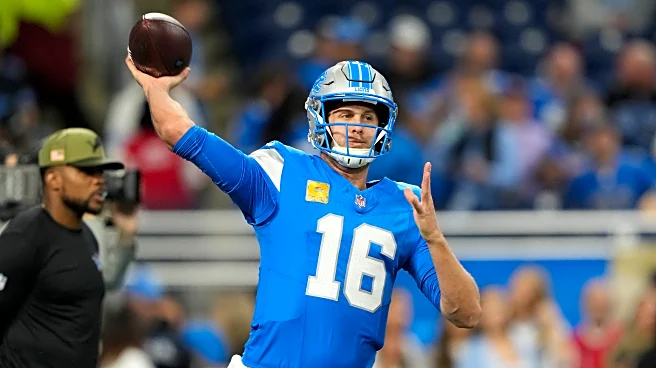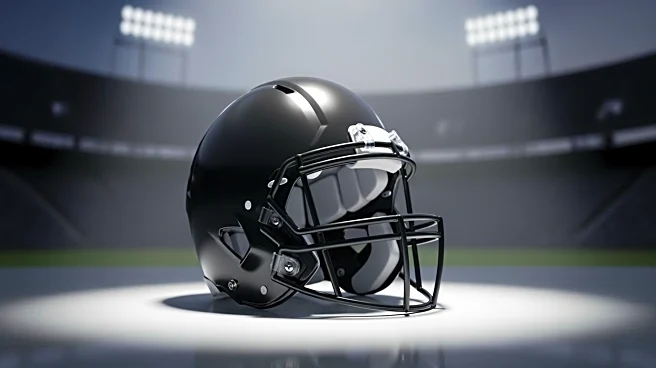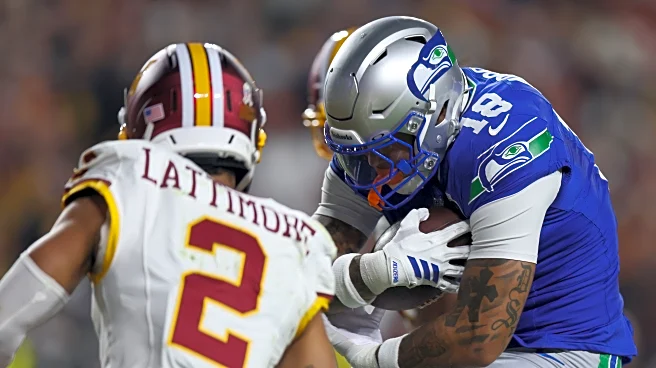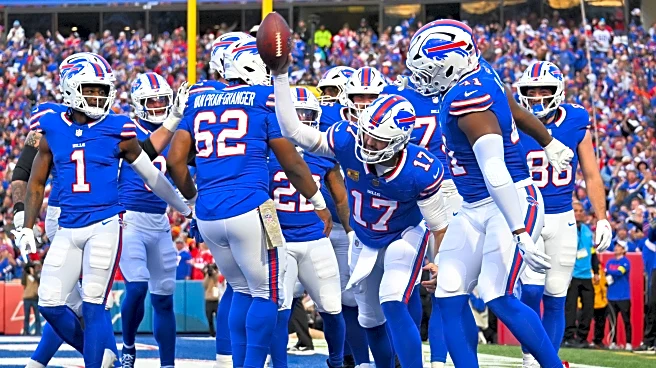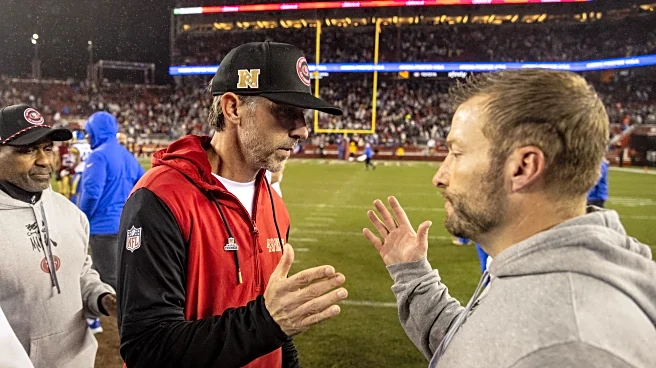The Detroit Lions (5-3) and Washington Commanders (3-6) will square off in a Week 10 matchup. The last time these two teams met, the Lions’ injury-depleted defense couldn’t keep up with Washington’s offense.
While things have changed this time around—the Lions defense is playing at a high level, and Commanders quarterback Jayden Daniels is injured and won’t play—Lions players haven’t forgotten about that loss.
“That’s definitely a part of it, absolutely,” Lions quarterback Jared Goff admitted earlier in the week. “I think more than that, we want to get off of a losing streak here and get a W. Certainly, you’re thinking about that, but I think it’s nine games ago now. So yeah, we’re trying to get a win this year and maybe use that as a little added motivation if we need it.”
If the Lions want to get back to their winning ways, they’ll need to follow the defensive keys to victory laid out in this week’s Honolulu Blueprint.
Commanders’ base schemes
For a detailed look at the opposing scheme, make sure you check out our complementary breakdown piece: Lions Week 10 Preview: Breaking down Commanders’ offensive and defensive schemes.
Key 1: Throw early and often
No matter what statistical measure you source—whether it be Jeremy Reisman’s On Paper, PFF, Next Gen Stats, SumerSports, etc.—the Lions’ biggest advantage in this game comes with their passing attack.
One unique system for exploring game matchups is NFL Pro, powered by Next Gen Stats. In their preview section, they combine 23 different Next Gen Stats to generate a 1-5 star ranking system for matchup comparisons. Most game previews show results that are distributed between both teams, with a few positive ratings that can favor one team by as many as 5 stars.
This week’s NFL Pro preview of the Lions’ passing game vs. the Commanders’ passing defense provided some overwhelming results:

That is a startling statistical advantage that significantly favors the Lions in virtually every category. So, what’s been the trouble in Washington? I broke down a handful of problems in the “Scouting notes” section of my scheme breakdown article this week, including the Commanders being slow to generate pressure, leaving open holes in coverage when they dial up aggression/blitz, a higher amount of bump-and-run coverage leading to late reactions and consistent trail coverage, deeper drops into zones leaving open space underneath for yards after the catch (YAC), and poor read-and-react decisions vs. play-action.
Look for the Lions to target Amon-Ra St. Brown and Sam LaPorta in the short and intermediate levels, where they can best use their YAC. Jameson Williams could also benefit from targets in this area, but he may be better served by running vertical routes, an area the Commanders have struggled to defend this season.
Here’s an excerpt from Next Gen stats to support that concept:
“The Commanders’ defense has allowed the 3rd-most completions (28) and a league-high 843 yards on vertical routes run by opposing receivers this season. In Week 9 against the Seahawks, they allowed Sam Darnold to complete 4 of 5 passes for 137 yards and 3 touchdowns when targeting his receivers on vertical routes.
“Matchup: Jared Goff has targeted a receiver running a vertical route on 14.2% of his passes this season, the 5th-lowest rate in the NFL but his highest rate in a season during his five-year tenure with the Lions. While he has targeted these routes more often, he has recorded a 44.1% completion percentage when doing so, his 2nd-lowest rate over the same period.”
With the Lions looking to get Williams more involved, this may be the perfect week to see that idea come to fruition.
Key 2: Outside zone
By the raw numbers, the Lions’ rushing attack and the Commanders’ rushing defense are not far apart statistically. The Lions have a slight advantage in DVOA (12 vs. 15), yardage gained (125.1 vs. 124.2), and yards before contact (1.55 vs. 1.53), while the Commanders have a slightly better success rate (allowing 39.2% vs. 39.6%), EPA (-0.02 vs. -0.04), and yards allowed after contact (2.86 vs. 2.89).
But if the Lions want to dial up their production, they’ll need to lean into what they prefer to do. In last week’s Honolulu Blueprint, I wrote a love letter to the Duo blocking scheme. This week, I’m asking for the Lions to lean into the blocking scheme they love: Outside zone.
The Commanders have an interior defensive line that has done well against inside runs and have held their gaps well of late. Typically a 1-gapping team, the Commanders have been slower to attack on run plays and appear to have been trying to clog rush lanes.
While anchoring the middle has been stout, it’s left them susceptible to stretch plays, where they’ve been much slower to react and track. That sets up well for the Lions to lean into their outside zone blocking scheme and could help them get their rushing attack back on track.
Key 3: Contain and squeeze Mariota
The Commanders’ entire offense has been built around quarterback Jayden Daniels, and with him dislocating his elbow last week, Washington is turning to backup Marcus Mariota. While Mariota is not the level of quarterback that Daniels is, he’s a veteran, and stylistically, he has been able to seamlessly fit into this offense several times this season—starting three of Washington’s nine games.
Mariota can execute this offense, and coaches have done a good job of adding little twists to the play-calling. Mariota gets into his passing sets quicker and leans into the tempo aspect of the scheme. The Commanders will still run RPOs with Mariota, as well as designed QB runs, and they’ve previously incorporated more run plays early in games.
“That offense is that offense, and they have full trust in Marcus Mariota,” Lions defensive coordinator Kelvin Sheppard told the media this week. “If anything, he’s bigger and a little more physical. […] They trust this player. It’s not a conservative approach to it. They’re down the field, striking just like if five (Daniels) was back there. So, we’re looking at it all the same, and we know it’s a great chance for us to bounce back after what they did to us in the NFC Divisional game last year.”
In that last meeting, the Lions didn’t have the personnel to contain Daniels, but that’s a much different story in 2025. The Lions have proven they have the skill players and play-calling to contain and squeeze mobile quarterbacks. That being said, they’ll also need to tighten up their gap defense a bit from last week.
Key 4: Defend the differences
While Sheppard is correct that the Commanders’ scheme is identical with Mariota at quarterback, there are a few things he does differently than Daniels.
For example, Daniels scrambles on 24.1% of offensive plays, while Mariota only scrambles on 13%, much closer to the league average of 12.8%. While Daniels is at his best when on the move, Mariota’s results are solid, but not exceptional, completing four of eight passing attempts for 81 yards and an incompletion, while rushing five times for 24 yards and two first downs.
Additionally, Mariota utilizes a lot of quick passes, makes quick decisions, and gets the ball into the hands of his playmakers. For reference, Deebo Samuel is the team’s leading receiver with 367 yards, but 213 have come after the catch. Mariota executes the tempo offense with purpose and leans on quick-hitting plays like slants and screens. When he is asked or needs to hold onto the ball for a longer designed play, things can unravel. The Lions’ press-man coverage will need to do the heavy lifting here.
Finally, Mariota has also been blitzed a whopping 43% of his dropbacks, the highest rate in the NFL. Teams have been quick to try and bring the heat on the veteran reserve, but he’s been surprisingly efficient, completing 61.5% of passes against the blitz with an 8.2 yards per pass attempt average. The Lions blitz on over 30% of their defensive snaps, but Sheppard has shown a tendency to hold back against certain opponents, and that could be the case this week as well.
Key 5: Early down success vs. run
Washington’s rushing stats are in the top 10 across the board. With Austin Ekeler on injured reserve, Washington has turned to seventh-round rookie Jacory Croskey-Merritt to be their primary running back.
“He reminds me of Malcolm (Rodriguez), I said that the other day. Kind of a late-round guy that snuck in the room and nobody really knew about him,” Sheppard said of the rookie back. […] “It’s no surprise to me when I turn on the tape of why: he runs hungry. […] Shoutout to that kid, a seventh-round pick that went in there and got it out of the mud. I’ll always respect guys like that in this league.”
But Croskey-Merritt isn’t alone as the team’s primary runner, as Washington will get all three of their running backs involved (Croskey-Merritt, Chris Rodriguez, and Jeremy McNichols), as well as their quarterback, and wide receiver Samuel. Daniels is their second leading rusher, but Mariota is also involved in RPOs and designed runs.
Look for the Lions to stay in their base defense as much as possible and continue to stack the box (38% of the time, second most in the NFL). If the Lions can hold Washington to short gains on early downs and get the Commanders’ offense off-schedule, it will play into the Lions’ strengths in pass defense while forcing Mariota to beat them by passing downfield.


